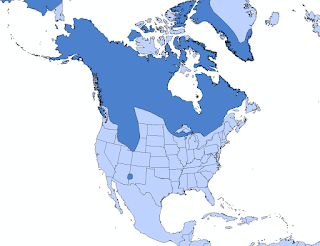Final Project Results
The Grey Wolf range extends through most of North America. In the United States, there are three main areas where there are these wolves. Area one includes Washington, Idaho, Montana, and Wyoming. Area two includes Minnesota, Missouri, and Wisconsin. The third area includes Arizona and New Mexico.
Humans have had a history of fearing these animals, and have hunted them almost to extinction. Although there are conservation actions being taken in the three main areas I listed above, their populations have a long road to recovery. The goal of my research was to find the best place(s) to introduce a Grey Wolf population.
I began my research looking at farm densities in each county of the United States. I wanted to locate areas that had a low farm density per square mile, in order to prevent the wolf population from preying on livestock, and creating a conflict with farmers. The lighter green areas had low farm densities, so I looked more closely in those counties.
After getting the information on the lowest farm densities, I wanted to know how many people lived in each of those counties. I decided to limit the population to 0-2.9 people per square mile. I made this number low for a similar reason as the farms- to limit conflict between the Grey Wolves and the population.
While limiting the options, I noticed that many of the counties that I could place the wolf population are very far apart. I want to try to find counties that are close together that have limited people, so that there is not a negative reaction to the introduced wolf population. In North and South Dakota, the counties that I could place the wolves are very far apart, so I have decided to cut them from the list. Oklahoma is also off the list because the only county that was found in that state had too many schools in that area.
Grey Wolf Range
Grey Wolf Range in the USA
Because Grey Wolves are very adaptable animals, they can be found in a variety of habitats. Although they are generalists, they prefer to live in boreal forests, high altitude grasslands, temperate forests, and temperate grasslands. These areas tend to have much larger mammals, which is an important food resource for wolves.
Preferred Grey Wolf Habitat
Possible Areas for Grey Wolf Placement
I began my research looking at farm densities in each county of the United States. I wanted to locate areas that had a low farm density per square mile, in order to prevent the wolf population from preying on livestock, and creating a conflict with farmers. The lighter green areas had low farm densities, so I looked more closely in those counties.
Farm Density by County
After getting the information on the lowest farm densities, I wanted to know how many people lived in each of those counties. I decided to limit the population to 0-2.9 people per square mile. I made this number low for a similar reason as the farms- to limit conflict between the Grey Wolves and the population.
Population Density by County
After looking at these results, and comparing them to the current Grey Wolf populations in the United States, I decided to remove the states with current populations as candidates because if more wolves were introduced into that population, there would most likely be more human-wildlife interactions, as well as increased conflict. Another issue is that a great number of predator species contained to one area would drastically effect hunting, which result in a decrease in other wildlife populations such as elk or deer. This could leave the wolf population eventually starving because they would outnumber their food supply, or hunters would kill off the wolf population if there weren't enough ungulates to hunt.
I also decided not to place the wolf population in CA because the single county they would have available is relativity small, and because there are not surrounding areas they could gather resources, they would have many interactions with people. Although there were wolves reintroduced to NM, I decided to keep those counties because the reintroduced population was very far away. After removing these areas, I was left with ND, SD, NB, CO, KS, OK, NM, and TX.
Potential Counties to Add Grey Wolf Population
With these counties, I began to add two busy human areas- hospitals and schools.
Schools and Hospitals
After I located the schools for each county, I went through each and selected the counties that only had one school, to minimize potential conflicts with humans and the wolf population.
Counties With One School
While limiting the options, I noticed that many of the counties that I could place the wolf population are very far apart. I want to try to find counties that are close together that have limited people, so that there is not a negative reaction to the introduced wolf population. In North and South Dakota, the counties that I could place the wolves are very far apart, so I have decided to cut them from the list. Oklahoma is also off the list because the only county that was found in that state had too many schools in that area.
Roads and Counties
After narrowing it down even more, I noticed that every county in Texas has a road passing through it. Although it is only one road, this helps eliminate more counties, since the wolf population may have a higher mortality rate compared to counties without roads. This leaves me with CO, KS, and NB as possible areas.
Counties to Add Grey Wolf Population












All of this looks great Maggie! It is clear that this project is something that you cared about and your maps are both informing and attractive. Congrats on finishing your project!
ReplyDelete